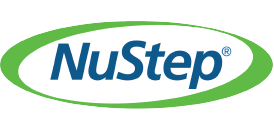NuStep’s for Limited Mobility
If you are living with limited mobility due to an injury, disability, chronic health condition, obesity or age-related frailty, the thought of achieving a total-body workout seems like an impossible feat.
You may ask, “How could this be possible if I can’t move my legs, have severe knee pain, diabetic neuropathy, balance problems, etc.?”
Here’s something that may surprise you. Total-body exercise is possible for virtually everyone – including those with limited mobility.
It may also surprise you to know that you can achieve an effective total-body workout while in a seated position. How? On a NuStep recumbent cross trainer- and here’s why.
Designed For Access And Ease Of Use
From the first iteration of our product back in the 1990’s to today, NuStep has focused on creating exercise equipment that people with a wide range of abilities can access and use. That’s why NuStep cross trainers are recumbent (seated); to accommodate people unable to stand for long periods of time or at all.
Our products have other features to enhance safe on and off access. They include a low step-through*, a large, comfortable seat (with a backrest) that swivels 360°, the StrideLock® mechanism and a sturdy grab bar. And, depending on the cross-trainer model, a user weight capacity that ranges from 400 to 600 lbs.
Design also plays a role in the NuStep’s functionality. From this standpoint, the design, which incorporates the mechanics of human movement and ergonomics, makes it easy to use.
The motion between the arms and the legs on the NuStep is fully connected. That means when the arm handles move, so do the foot pedals. Moreover, NuStep cross trainers have a low inertia start-up. As such, they don’t require a Herculean effort to get the arms and legs moving and keep the momentum going.
Therefore, even if you can only use your arms to power the NuStep, your legs move whether they are “helping” or not. The same is true if you can only power the NuStep with your legs. In other words, even though the movement in some limbs is passive, they are moving and you are exercising your upper and lower body.
Finally, the adjustment levers on all NuStep models are easy to use. For example, clamshell release levers, instead of knobs, are used to adjust the arm handles. Rather than twisting a knob, which may be difficult for some, the clamshell release levers are easy to lift up and push down.
Adaptive Equipment For Advanced Support
Some users, however, require additional support when using the NuStep so they can achieve the most effective workout possible. That’s why we developed our line of adaptive equipment and accessories.
The Leg Stabilizer offers advanced support for users with weakness or paralysis in one or both legs. It works to secure and stabilize the user’s legs, keeps them in neutral alignment and promotes a full range of leg movement.
For users with weakness or paralysis in one or both arms, The WellGrip® helps them grip the NuStep handles and support their wrists. Users can then maintain a stable, correct hand position during their workout and get full range of upper body motion.
Living with limited mobility poses many challenges. At NuStep, we work hard to make sure access to safe, effective exercise isn’t one of them.
*not available on the T4r cross trainer model

